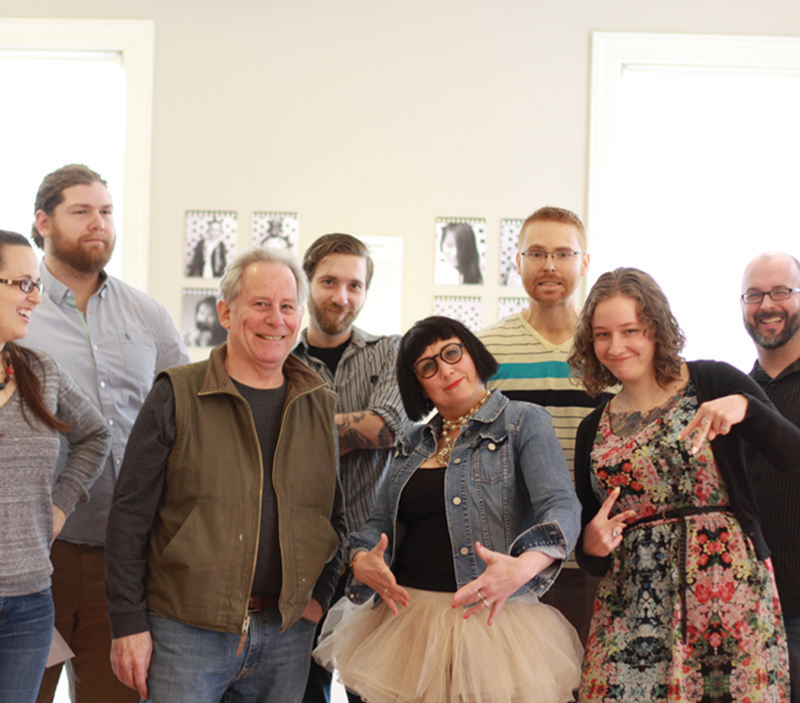The role of art collecting in the emerging (and possibly illusory) “sharing economy” has yet to be set, but the local experiments with community ownership/financing of artworks keep growing.
The two local community supported art (CSA) groups — C-S-Arts Cincinnati and The Carnegie CSA — have both announced plans for 2015 after their first seasons last year, and there could be some interesting expansions in their future.
Meanwhile, a Xavier University associate art professor, Jonathan Gibson, has come up with an unusual variant. He’s created a mural-sized paper collage of dancers in movement, and through a Kickstarter campaign called Art of Parts was selling it in cut-up pieces to those who buy in. The amount of money they pledge determines the amount of the collage they receive — there is a $25 minimum.
“I’ve always wanted to make art that’s affordable [to buyers] and could never figure out how to do it,” Gibson says. “You either have to undervalue your work, make prints or restrict its size. This is proportional ownership of a work among a group of people rather than a single wealthy owner.”
There’s a scale version of the 125-by-42-inch digital collage and a video on how Gibson created it at artofparts.com.
The Kickstarter campaign, which had set a goal of $9,000, officially ended last week well short of Gibson’s goal. He generated $3,280 from 29 backers. However, he now plans to sell sections of the work through his own website.
C-S-Arts Cincinnati and The Carnegie CSA were both inspired by a successful venture in Minneapolis/St. Paul, now in its sixth season. (It, in turn, was inspired by community supported agriculture programs.)
C-S-Arts has just issued a call for nine artists to apply with proposals for commissions (at $1,200 each). Those chosen would each create 50 relatively small artworks for the 50 “shareholders” who will each pay $350 in advance. For that price, each will receive a total of nine artworks that — like produce — are delivered in crates. The artists also get a show at Kennedy Heights Arts Center.
Artist applications can be filled out online at csartscincinnati.org through May 2. The jurors who will review them later in May and award commissions (or shares) are Katie Gephart, Taft Museum of Art curatorial assistant; Robert Probst, dean at the University of Cincinnati’s College of Design, Architecture, Art, and Planning; and Abby Schwartz, director of Hebrew Union College’s Skirball Museum. After that, C-S-Arts will solicit art-loving shareholders.
This is roughly how C-S-Arts Cincinnati did things last year. But there may be — and I emphasize may — a significant addition this year.
“We’re looking at possibly having a performance as one of the pieces,” says Amy Banister, one of the seven members of the group’s planning committee. “So people would get eight physical pieces and then be able to bring a guest and attend a performance done exclusively for C-S-Arts shareholders.”
Banister notes that one of the artist choices in last year’s second season, the duo of Chelsea Borgman and Justin West, combined sculpture with a piece of original music.
C-S-Arts Cincinnati is different organizationally from The Carnegie CSA. While C-S-Arts Cincinnati is volunteer-run and was initiated by Jared Queen, The Carnegie CSA is organized by Matt Distel, its exhibitions director, and The Carnegie does get some revenue.
Distel selects the artists himself and recently announced them for 2015: They are Tony Dotson, Factory 15 (Leah Busch and Sandra Gross), Future Retrieval (Guy Michael Davis and Katie Parker), Terence Hammonds, Homeadow Song (Peter Huttinger and Vicki Mansoor), Tony Luensman, Mark Patsfall, Sara Caswell Pearce and Bill Ross (with Bob Scheadler and Sharon Butler).
Their art will be delivered all at once on July 24, when shareholders receive their “farm box.” Shares are now on sale at thecarnegie.com for $350. The Carnegie is offering a $25 discount for last year’s shareholders who return their box for recycling.
As for whether these participants will branch out beyond traditional two- and three-dimensional visual art, Distel doubts it. But he can’t be sure since Homeadow Farm is an actual homestead that, among other things, raises bees for honey.
“Peter and Vicki sort of merge their art with gardening and farming,” Distel said. “So we might end up with honey in a crate.”
But probably not bees, he said.
CONTACT STEVEN ROSEN: [email protected]


